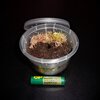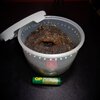Colorado Ts
Arachnoangel
- Joined
- Oct 16, 2019
- Messages
- 829
I see these posts a lot. Seldom does a week go by without someone asking how to setup an enclosure, what substrate to use, what size enclosure...what to feed, etc.
Those of you, who have a system for raising slings, what is your system? How do you do it?
I look forward reading to your approaches.
My Method: Terrestrial Slings
All my slings are kept in a cabinet with sliding glass front doors. The cabinet has been modified with the addition of a thermo regulator set at 79 degrees and a small ceramic space heater on the bottom shelf. A breeder was telling me the other day that he uses heat tape...not sure what is, but he was very supportive of it use. So I'll look into it and report my findings later. Slings are stored beginning on the top shelf, with over flow going to the second shelf as needed. No slings are ever kept on the bottom shelf, due to heat concerns. Once slings reach a size of 2” to 3” they are then moved to adult enclosures and setup in the spider room, where the temperature varies from 74 degrees to 78 degrees...usually.
All slings are fed twice a week. When moved into the spider room, they are then fed once a week, or once every other week.
All enclosures are labeled, for identification and tracking.
Sample label:
AphoSee#1
Aphonopelma seemanni, Brown Phase
17th November 2019 Adult 5” Female
Private Purchase, Ft Collins, $15.00
The label contains all information that I want to identify the spider, and stays with the spider until it dies or is re-homed to someone else. I also have a tracking document in Word, that has this same information, with the addition of moulting dates and a journal of observation for the species and observations for individual spiders using their ID. If anything happens to the spider then the label in the Word document is updated to indicate final disposition and a journal entry is made that contains all the details.
1/2” slings (Terrestrial)
I don't go smaller than 1/2” when bringing in slings. I'm not set up for it yet. So I'll start with the 1/2” size.
For these slings, I use AMAC boxes that measures ~1.25” X 1.25” X 2”. Small surface area and the sling is able to burrow. At about a centimeter below the lid, I drill evenly spaced holes on two opposite sides of the enclosure for cross ventilation. The substrate is coco fibre that is packed into the enclosure leaving about 3/4” to 1” from substrate to lid. I’ll put a starter burrow in two opposite corners, and lightly moisten the substrate.
The slings are transferred into the enclosure and offered a food item after 24 to 48 hours of acclimation. Small crickets or small roaches are offered as food. If the sling is refusing live food on multiple occasions, then they are fed a scavenger diet of cricket parts or roach parts.
3/4” to 1” slings (Terrestrial)
For slings of this size range, or smaller slings that have grown into this size range, I use AMAC boxes that measure 4” X 4” X 4” Primarily. I do also use a couple boxes that are 4” X 4” X 6” for some species. At about a centimeter below the lid, I drill evenly spaced ventilation holes on two opposite sides for cross ventilation. The substrate is again coco fibre that is packed into the enclosure. For most species I'll use moist substrate. (For Chromatopelma cyaneopubescens I'll use 3/4” dry substrate with a hide and added anchor point to encourage webbing.)
The substrate is sloped into one corner, and packed creating a contoured surface. I then pack a channel in the substrate and then press a cork bark over the channel. When completed, this will look like a tiny hill that has a small hole with a chunk of wood over the top. I then cut up moss into small chunks and scatter it around the sides and on top of the hill that forms the top of the enclosure. I leave the area in front of the hide as a depression with no moss. Since doing this, the sling almost always chooses to enter the hide and start burrowing. By setting up the hide and channel into a corner, the sling will have depth, and will always burrow into the corner, creating a nice little room with two windows and sometimes even a floor window for viewing.
I also include a water dish, that is probably a bottled water lid. This it put on top of the hide or high up on the sides to one side or the other. If put in the depression in front of the burrow entrance, the water is simply filled every day with...stuff. For some species it won't matter where you put the water dish it will be filled with stuff.
The slings are transferred into the enclosure and offered a food item after 24 to 48 hours of acclimation. I feed the slings roaches. I raise my own roaches, B lateralis & B. dubia.
The slings will remain in this enclosure until they reach 2” to 2.5”...or if I'm a bad person, 3”. Then they are transferred to adult accommodations.

I assemble my enclosures days before the slings arrive. Here is a stack of enclosures waiting to be labeled.
Those of you, who have a system for raising slings, what is your system? How do you do it?
I look forward reading to your approaches.
My Method: Terrestrial Slings
All my slings are kept in a cabinet with sliding glass front doors. The cabinet has been modified with the addition of a thermo regulator set at 79 degrees and a small ceramic space heater on the bottom shelf. A breeder was telling me the other day that he uses heat tape...not sure what is, but he was very supportive of it use. So I'll look into it and report my findings later. Slings are stored beginning on the top shelf, with over flow going to the second shelf as needed. No slings are ever kept on the bottom shelf, due to heat concerns. Once slings reach a size of 2” to 3” they are then moved to adult enclosures and setup in the spider room, where the temperature varies from 74 degrees to 78 degrees...usually.
All slings are fed twice a week. When moved into the spider room, they are then fed once a week, or once every other week.
All enclosures are labeled, for identification and tracking.
Sample label:
AphoSee#1
Aphonopelma seemanni, Brown Phase
17th November 2019 Adult 5” Female
Private Purchase, Ft Collins, $15.00
The label contains all information that I want to identify the spider, and stays with the spider until it dies or is re-homed to someone else. I also have a tracking document in Word, that has this same information, with the addition of moulting dates and a journal of observation for the species and observations for individual spiders using their ID. If anything happens to the spider then the label in the Word document is updated to indicate final disposition and a journal entry is made that contains all the details.
1/2” slings (Terrestrial)
I don't go smaller than 1/2” when bringing in slings. I'm not set up for it yet. So I'll start with the 1/2” size.
For these slings, I use AMAC boxes that measures ~1.25” X 1.25” X 2”. Small surface area and the sling is able to burrow. At about a centimeter below the lid, I drill evenly spaced holes on two opposite sides of the enclosure for cross ventilation. The substrate is coco fibre that is packed into the enclosure leaving about 3/4” to 1” from substrate to lid. I’ll put a starter burrow in two opposite corners, and lightly moisten the substrate.
The slings are transferred into the enclosure and offered a food item after 24 to 48 hours of acclimation. Small crickets or small roaches are offered as food. If the sling is refusing live food on multiple occasions, then they are fed a scavenger diet of cricket parts or roach parts.
3/4” to 1” slings (Terrestrial)
For slings of this size range, or smaller slings that have grown into this size range, I use AMAC boxes that measure 4” X 4” X 4” Primarily. I do also use a couple boxes that are 4” X 4” X 6” for some species. At about a centimeter below the lid, I drill evenly spaced ventilation holes on two opposite sides for cross ventilation. The substrate is again coco fibre that is packed into the enclosure. For most species I'll use moist substrate. (For Chromatopelma cyaneopubescens I'll use 3/4” dry substrate with a hide and added anchor point to encourage webbing.)
The substrate is sloped into one corner, and packed creating a contoured surface. I then pack a channel in the substrate and then press a cork bark over the channel. When completed, this will look like a tiny hill that has a small hole with a chunk of wood over the top. I then cut up moss into small chunks and scatter it around the sides and on top of the hill that forms the top of the enclosure. I leave the area in front of the hide as a depression with no moss. Since doing this, the sling almost always chooses to enter the hide and start burrowing. By setting up the hide and channel into a corner, the sling will have depth, and will always burrow into the corner, creating a nice little room with two windows and sometimes even a floor window for viewing.
I also include a water dish, that is probably a bottled water lid. This it put on top of the hide or high up on the sides to one side or the other. If put in the depression in front of the burrow entrance, the water is simply filled every day with...stuff. For some species it won't matter where you put the water dish it will be filled with stuff.
The slings are transferred into the enclosure and offered a food item after 24 to 48 hours of acclimation. I feed the slings roaches. I raise my own roaches, B lateralis & B. dubia.
The slings will remain in this enclosure until they reach 2” to 2.5”...or if I'm a bad person, 3”. Then they are transferred to adult accommodations.

I assemble my enclosures days before the slings arrive. Here is a stack of enclosures waiting to be labeled.
Last edited:































